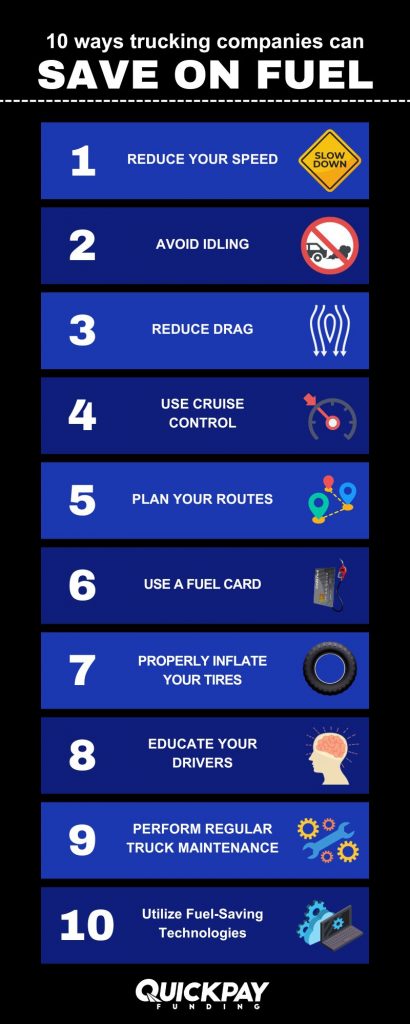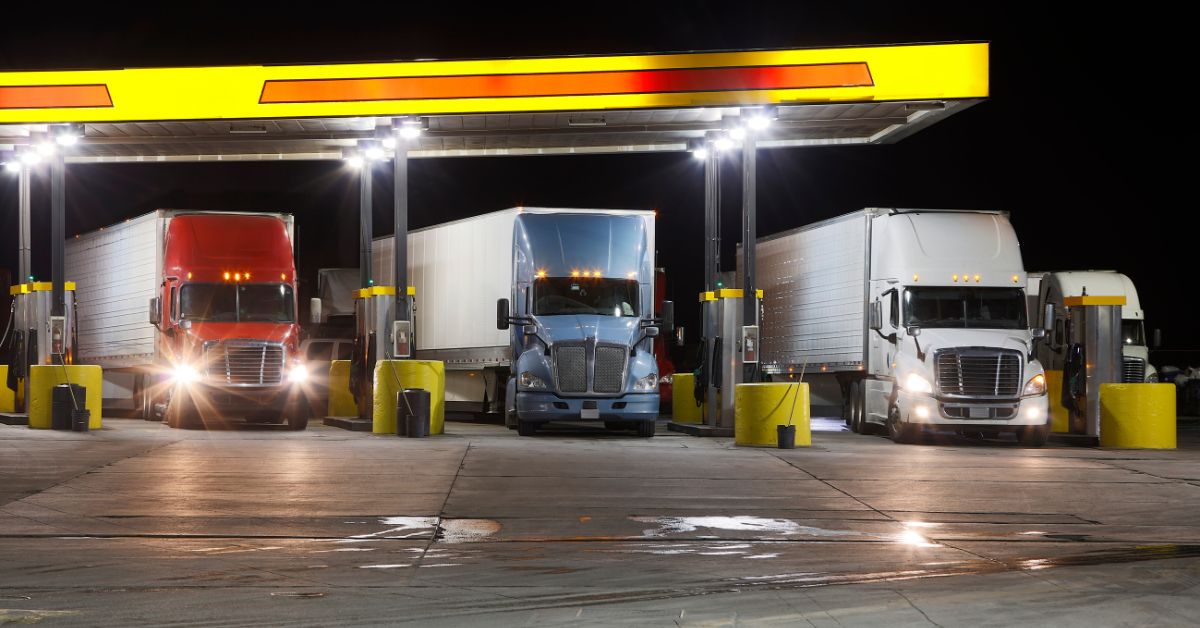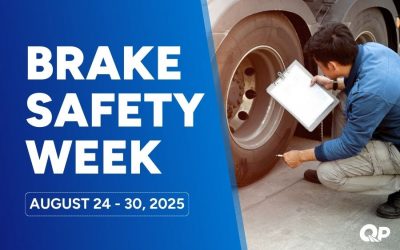Diesel fuel is one of the biggest expenses for trucking companies, accounting for up to 40% of operating costs. With fuel prices on the rise, it is more important than ever for trucking companies to find ways to reduce their fuel expenses.
10 ways trucking companies can reduce their diesel fuel expenses
1. Reduce Speed
Slowing down is one of the simplest yet most effective ways to reduce fuel consumption. For every mile per hour slower you drive, your fuel efficiency will increase by 0.14 mpg. In fact, when truckers reduce their speed from 75 mph to 65 mph, they reduce their fuel consumption by 27%. According to Glen Kedzie, vice president of environmental affairs for the American Trucking Associations, the “sweet-spot” for most 18-wheelers is around 60-65 mph.
2. Avoid Idling
Idling waste fuel and money. According to the U.S. Department of Energy, idling for more than five minutes uses more fuel than restarting the engine. If you’re going to be stopped for more than five minutes, turn off the engine.
3. Reduce Drag
Drag is the resistance that your truck faces as it moves through the air. Reducing drag can help improve fuel efficiency. Here are some of the easiest modifications that can yield noticeable improvements in fuel efficiency:
- Side Skirts: Side skirts are panels that run along the lower sides of a semi-truck and trailer. They help streamline airflow by covering the gap between the wheels, reducing turbulence and improving fuel efficiency.
- Gap Reduction: Gap reduction refers to minimizing the space between the tractor and trailer, which decreases the open area that causes aerodynamic drag. This is achieved by adjusting the fifth wheel position and connecting the two units closely.
- Keep the Truck and Trailer Clean: Keeping the truck and trailer clean involves regular maintenance to ensure a smooth and dirt-free surface. A clean exterior minimizes disruptions to airflow, reducing drag and enhancing fuel efficiency.
- Wheel Covers: Wheel covers, also known as hubcaps, are protective shields that encase the wheels of a semi-truck. They reduce turbulence around the wheels, enhancing aerodynamics and improving fuel efficiency.
- Boat Tail: A boat tail is an aerodynamic extension added to the rear of a trailer. Shaped like the tail of a boat, it helps streamline airflow at the back of the truck, reducing drag and increasing fuel efficiency.
4. Use Cruise Control
Cruise control can help you maintain a steady speed, which is important for fuel efficiency because it reduces unnecessary acceleration and deceleration. However, it’s important to note that cruise control is not always the best option. For example, if you’re driving in hilly terrain, it’s better to manually control the speed of your truck.
5. Plan Your Routes
Careful route planning can help you avoid unnecessary miles and traffic congestion. This can save you fuel and time. When planning your routes, be sure to factor in things like traffic patterns, weather conditions, and of course plan your route based on what truck stops offer the best fuel prices.
6. Use a Fuel Card
Fuel cards are valuable tools that help truckers save on fuel costs and streamline fuel-related transactions. They are typically issued by fuel providers or financial institutions and provide access to discounted fuel rates at participating gas stations and fueling locations. These discounts are typically negotiated by the issuer, often in partnership with major fuel providers, and result in lower per-gallon fuel prices. This immediate reduction in fuel costs can be a significant advantage, especially for trucking companies with large fleets, as it directly impacts the bottom line.
Additionally, fuel cards offer detailed tracking and reporting features that allow truckers and fleet managers to monitor fuel consumption with precision. By providing insight into where, when, and how fuel is purchased, these cards make it easier to identify and address inefficiencies and unauthorized fuel purchases. This, in turn, helps enforce fuel-saving policies, minimize fraudulent activities, and ensure that fuel is used solely for legitimate business purposes.
7. Properly Inflate Your Tires
Properly inflated tires help truckers save on fuel in two main ways:
- Reduced rolling resistance: Underinflated tires have a larger contact patch with the road, which increases rolling resistance. Rolling resistance is the force that opposes the forward motion of a vehicle. The more rolling resistance there is, the more energy is required to move the vehicle. By properly inflating their tires, truckers can reduce rolling resistance and improve fuel efficiency.
- Reduced wear and tear: Underinflated tires are more likely to wear out prematurely. This is because the increased contact patch with the road causes the tires to generate more heat, which can lead to tread separation and other problems. Properly inflated tires last longer, which saves truckers money on tire replacement costs.
According to the North American Council for Freight Efficiency (NACFE), a truck with tires underinflated by 10 psi can experience a 0.5-1.0% increase in fuel consumption. This may seem small, but it can add up to significant savings over the course of a year. For example, a truck that travels 100,000 miles per year could save up to $1,000 on fuel costs by properly inflating its tires.
8. Educate Your Drivers
Your drivers play a major role in fuel efficiency. Educate them on fuel-efficient driving practices, such as avoiding speeding, idling, and jackrabbit starts. A study by the U.S. Department of Energy found that drivers who received training in fuel-efficient driving techniques improved their fuel economy by an average of 5%.
9. Perform Regular Truck Maintenance
A well-maintained truck is inherently more fuel-efficient. Routine maintenance tasks, such as engine tune-ups, filter replacements, and timely oil changes, ensure that the truck’s components function at their best. This means the engine runs smoothly, air filters are clean, and oil is fresh, allowing for optimal fuel combustion and reduced energy waste. Proper maintenance helps keep the engine in peak condition, ensuring it consumes fuel more efficiently, which translates into cost savings over time.
Regular truck maintenance is a sound investment that not only significantly contributes to fuel savings but also ensures the safety and reliability of a truck. It helps maintain peak fuel efficiency, reduces breakdowns and downtime, prevents costly repairs, and extends the lifespan of vehicles, all of which are crucial for the financial health of trucking companies.
10. Utilize Fuel-Saving Technologies
There are a number of fuel-saving technologies available for trucks. These technologies can help improve fuel efficiency by reducing drag, optimizing engine performance, and more. Some common fuel-saving technologies include:
- Auxiliary power units (APUs)
- Aerodynamic devices
- Fuel additives
- Telematics systems
By implementing a combination of these tips, trucking companies can make a significant impact on their fuel costs. This can help improve their profitability and make them more competitive.

Additional fuel saving tips
Here are a few additional tips that trucking companies can use to save on fuel:
- Reduce the weight of your trucks by using lighter materials for the body and components, and by removing any unnecessary items.
- Negotiate fuel discounts with fuel suppliers.
- Partner with other trucking companies to save on fuel costs.




